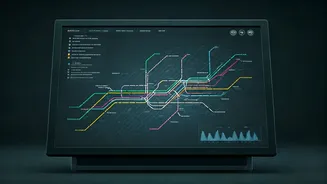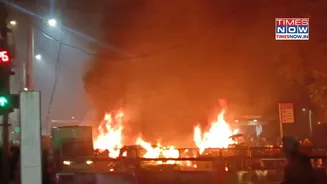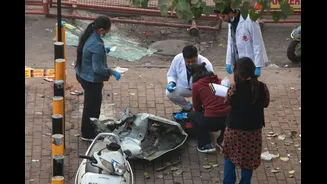Blue Line Overview
The Delhi Metro's Blue Line stands as a vital component of the city's public transportation. It stretches across a significant portion of Delhi and its
neighboring areas, linking key locations and easing the daily commute for countless residents. The Blue Line serves as an essential transport network, significantly improving accessibility within the National Capital Region. The line's route encompasses numerous stations, each strategically placed to cater to the needs of commuters. Operationally, the Blue Line adheres to a strict schedule, ensuring regular and efficient services. Timings are carefully designed to accommodate peak travel hours and provide convenient options for passengers throughout the day. The Blue Line's service is designed to seamlessly integrate with other metro lines and public transport, providing a robust transport system in Delhi. Its operational efficiency contributes significantly to the smooth functioning of daily activities for a vast segment of the population. The route's expansion and ongoing improvements highlight the metro's dedication to continuously improving its services and better serving the public.
Key Station Details
The Blue Line is dotted with strategically positioned stations that facilitate convenient access to multiple areas of Delhi and beyond. Among the crucial stations is Dwarka Sector 21, which provides seamless connectivity to the Airport Express Line, enhancing accessibility for air travelers. Janakpuri West is another pivotal station, serving as an interchange point with the Magenta Line, thereby providing multiple route options for commuters. The station at Rajiv Chowk serves as a significant hub, intersecting with the Yellow Line and facilitating easy transitions between north and south Delhi. Moreover, the Noida Electronic City station acts as a crucial terminal for commuters traveling to and from Noida. Other key stations like Vaishali and Dwarka offer convenient access to important residential and commercial areas, which play a huge role in the transport network. These stations feature various amenities, contributing towards a smoother travel experience for daily commuters.
Route and Connectivity
The Delhi Metro Blue Line traverses a broad pathway, effectively linking the city's prominent regions. The main line initiates at Dwarka Sector 21 and proceeds through various key areas before terminating at Noida Electronic City. This route is strategically designed to provide extensive coverage and facilitate smooth transportation. The Blue Line also features a branch line that extends from Yamuna Bank to Vaishali, which widens the scope of its accessibility and offers greater convenience to commuters in various regions. This network allows easy transfer to other metro lines, enhancing overall connectivity in the Delhi metro system. The integration of the Blue Line with other lines, like the Yellow Line at Rajiv Chowk and the Magenta Line at Janakpuri West, allows seamless transitions. These interconnected hubs are crucial to managing commuter flow. This interconnected design provides passengers with various transportation possibilities across the capital and its adjacent regions. The Blue Line's comprehensive route map guarantees that essential areas are effectively linked, making Delhi's public transportation network accessible to a larger demographic.
Operational Aspects
The Blue Line functions with a structured timetable, ensuring efficient movement throughout the day. Timings are thoughtfully planned to suit peak commuting hours and make sure services are available to commuters. The line generally starts its services early in the morning and concludes late at night, making sure it addresses the requirements of a wide user base. Real-time updates and announcements are provided at stations and inside the trains, to keep passengers informed about schedules, delays, or any operational changes. DMRC provides a mobile application named 'DMRC Momentum,' which offers information like route maps, station details, and fare information, which also enhances passenger convenience. The line's operational integrity is improved by routine maintenance and safety checks, improving the passenger experience. The maintenance schedule ensures that services are constantly upgraded and safe for use, and it is a key part of the Delhi Metro's operational strategy.
Real Estate Impact
The presence of the Blue Line has significantly affected the real estate landscape in areas around its stations. The establishment of metro stations, like those in the Dwarka area, has boosted property values, making these areas desirable for both residential and commercial investments. Areas near metro stations usually experience higher demand because of improved accessibility and connectivity. Locations that have metro access usually attract more buyers and renters, which improves the market prices and growth of the surrounding localities. The rise in property prices is evident in areas like Noida, where the Blue Line's presence has transformed the real estate market. Furthermore, the integration with other metro lines, like the Yellow and Magenta Lines, boosts accessibility. This increases the attractiveness of properties nearby and makes it possible for property owners to fetch higher prices. The Blue Line has become a crucial element of the urban infrastructure, providing a strong environment for the real estate sector.
Future Developments
The Delhi Metro is always looking to expand and enhance the Blue Line's features to improve passenger convenience and network efficiency. Platform extensions at 32 stations are planned to house trains with 8 coaches. This strategic expansion is meant to alleviate congestion, particularly during rush hours, and to make sure services keep up with the increasing demand. Moreover, plans for expanding the Blue Line to include new areas in the Delhi NCR region are constantly under development. These planned routes are designed to enhance connectivity. These strategic developments highlight the Delhi Metro's ongoing dedication to serving its citizens by making sure its transportation network matches the changing needs of a growing city. The constant improvements and upgrades show the long-term aim of providing efficient, dependable, and cutting-edge public transportation options to the people of Delhi and its surrounding regions.















